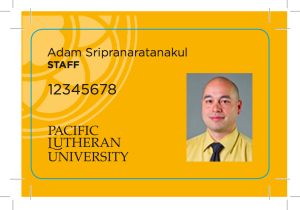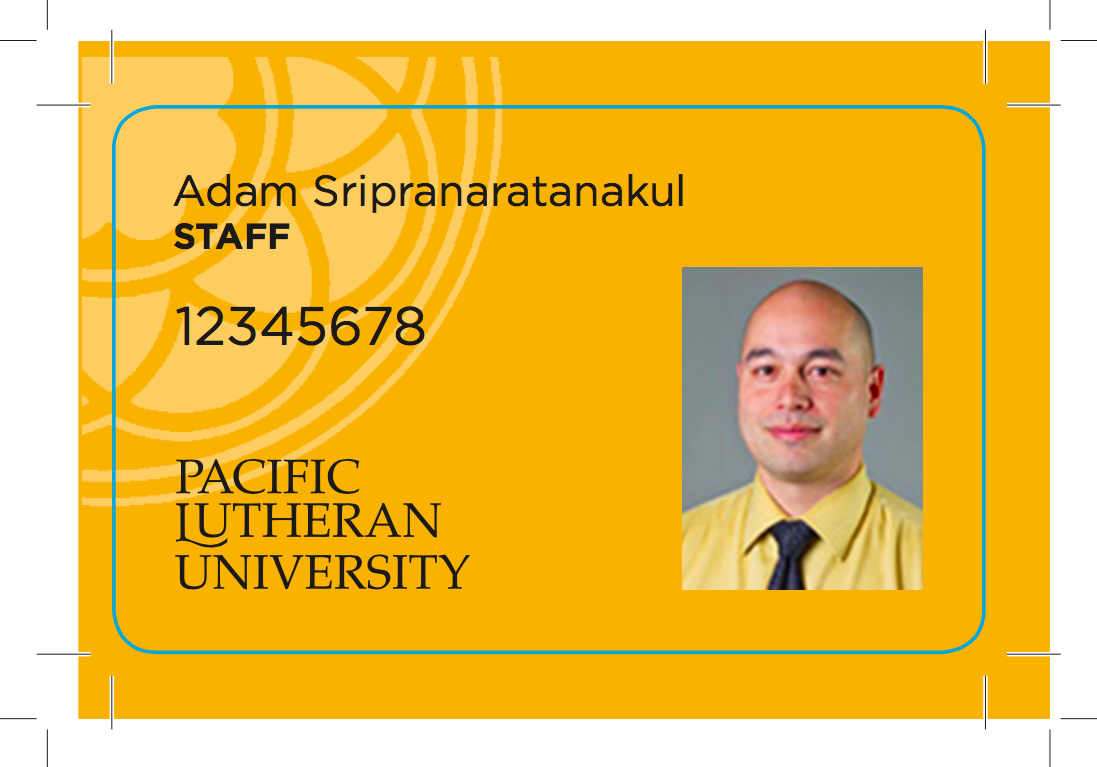Lutecards, the IDs used at Pacific Lutheran University, aren’t the biggest news-makers on campus, but this summer they’re making a splash.
Starting with Xavier, buildings are switching over to “contactless entry” – tapping your card to a reader instead of swiping it; and to accompany the advancement is a completely redesigned Lutecard. It took four PLU organizations working together to accomplish the task.

Managing cards
First, the advocate for redesign and the manager of cards: Adam Sripranaratanakul, Manager of Concierge Services – the department that manages Lutecard services. He decided “it would be fun to introduce a new design,” when he heard about new card technology being rolled out. A redesign was a way to “get students excited about the PLU spirit and colors as well as the new power of the card.”
Changing access and spending money
Second, on the actually changing buildings side, there is Pat Henness, Building Access Administrator, and Ginger Peck, Director of Auxillary Services. They have been working on a long-range project (since 2008) to switch all building access from card swipes to contactless entry.
In order to switch the entry system, they had to switch the cards. The cards switched in 2014, when Stuen opened from remodeling, featuring contactless locks on interior doors (Ordal now features that technology, too). All the new cards, in addition to those of Stuenites, are dual-credential cards, featuring a contactless chip and a magnetic stripe. Both contain data necessary to tell the techonology who they are and if they have access, dining dollars, Lutebucks, printing money and so on.
This summer, Xavier, which was one of five buildings on campus that used a traditional key-and-doorknob unlocking system, went through an approximately $20,000 update to contactless entry, Peck said. The four other hard-key buildings – Ramstad, Names, Memorial and Colombia Center – will be the next to receive the update.
The funds come from the Auxiliary Services Building Access budget. In the last budget year, Peck says they were given a “fast track” to update this technology. Hard-key buildings like Xavier will be the most expensive, as they must start from the ground-up; buildings with magnetic swipe access will vary in price but will cost “significantly” less.
There is no estimated finish date for non-residential buildings, completion will rely entirely on what the budget allows. There is also no plan to replace swipe technology related to dining or retail (for example, copying at the library or purchasing from OMM) because that would be “too much of an expense,” Peck said.
While there will be some “initial investments,” as Peck describes the $20,000 Xavier price tag, contactless technology may save PLU money in the long run. The new tech is much more economically sustainable, Henness said, because cards can easily be shut down and reprogrammed when lost. If a hard key is lost, a whole lock or system of locks must be recorded, which eventually costs a “tremendous amount of money.”
Residential Life: “Haven’t made any plans.”
The third group involved is in charge of residential halls – that’s residential life. Tom Huelsbeck, Associate Vice President for Campus Life, said that every dorm built or remodeled after Stuen will have interior contactless locks. As for contactless exterior doors: “That’s obviously the direction campus is going, but we haven’t made any plans yet.”
The actual card

Finally, the actual redesign comes from Marketing and Communications. The new card features the streamlined look of PLU, most recently displayed in the Spring redesign of the PLU.edu website. The new card was designed by Simon Sung, Executive Creative Director, who is responsible for many of PLU’s graphic design.
This is the first redesign of the card since 1996. Prior to 1996, cards were individually laminated.
NEW INFO (11 p.m. August 20, 2015): The new card will be issued to incoming first-years when they arrive on campus in Fall and incoming juniors, due to a Spring 2015 ASPLU legislation which funded refreshing the entire class’ Lutecards. Returning sophomores or seniors can opt to purchase a new Lutecard, which is $10 to trade an old card for a new one, and $30 if the old Lutecard is not turned in. Concierge Services also guarantees that students who need dual-credential cards (such as for Residential Hall room entry in Stuen or newly-renovated Ordal) will be given them at no charge.
Lutecards are infamous for their tendency to peel and disintegrate over time. Sripranaratanakul says the newly-designed cards will lose this reputation – they are “much more durable” and do not peel.
Faculty and staff who want the new, tougher and better-looking card will have to wait until Concierge Services runs out of their current stock of dual-credential cards with the old design.



















